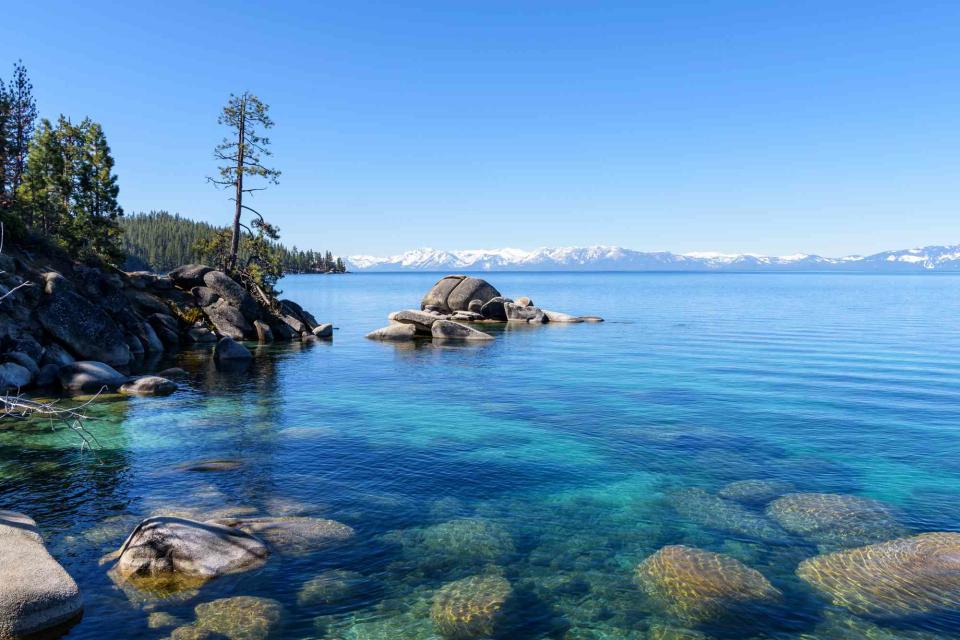Lake Tahoe Is the Clearest It's Been in 40 Years — Here's Why
The credit goes to microscopic animals, according to a new report.

Yaya Ernst/Getty Images
The largest alpine lake in North America is the clearest it has been in more than 40 years — and the credit goes to microscopic animals.
Lake Tahoe, a popular tourist destination that sits on the border of California and Nevada, receives more than 15 million visitors a year, according to the Lake Tahoe Tourism Board. Known for its clear waters, the lake saw a decline in water clarity over the past half-century. Now, it is experiencing dramatic improvement with some of the clearest water recorded since the 1980s.
The water clarity findings are part of the “Lake Tahoe Clarity Report 2022” from the UC Davis Tahoe Environmental Research Center and the Tahoe Regional Planning Agency (TRPA).
The team measured clarity by lowering a 10-inch white disk, called a Secchi disk, under the lake's surface to record the depth at which it disappeared from view. Lake Tahoe’s average annual clarity saw a massive upgrade from 2022 to 2021: It went from 61 feet in 2021 to 71.7 feet in 2022. The report predicts the ultra-clear waters to get even clearer through 2023.
Environmental experts hope the lake clarity will further improve in future years. The goal is to bring the clarity back to 97.4 feet.
The research team says the lake’s native zooplankton, which recently surged in population, is responsible for the change. The microscopic animal helps keep the lake clear by eating tiny particles that make the water cloudy. “They’ve provided a natural clean-up crew to help restore the lake’s famous blue waters,” scientists said in the report.
Zooplankton declined in the 1960s after its main predator, the Mysis shrimp, experienced a population surge. According to the report, the shrimp population “unexpectedly crashed" in 2021, allowing zooplankton numbers to spike. (This means if the crustaceans make a comeback, the lasting effect of the clear water is temporary.)
Another element is pollution control. The report states special projects keep around 500,000 pounds of "fine sediment and other clarity-harming pollutants" out of Lake Tahoe every year.
“The lake’s resilience must continue to be supported by regional investments in water quality, forest health, and aquatic invasive species prevention and control,” TRPA executive director Julie Regan said in a statement obtained by Travel + Leisure.
For its part, Lake Tahoe’s lodging industry has also taken steps to help preserve the lake water’s quality and give back to the environment through partnerships and programming.
The Ritz-Carlton, Lake Tahoe, for example, created several programs to reduce single-use plastics, and hotel staff and guests can sign up for a “Keep Lake Tahoe Blue” clean-up event twice a year. “We feel these initiatives will have a lasting effect on saving our environment and are more responsible sustainable solutions,” Laurie Munos, the director of sales and marketing at The Ritz-Carlton, Lake Tahoe, told T+L.
Edgewood Tahoe Resort is also focused on being an environmental steward. The hotel's executive director of marketing and sales, Siobhan Fajayan, told T+L: “From removing 500,000 pounds of sediment per year from Lake Tahoe via enhanced wetlands and deepened filtration settling ponds to partnering with Clean Up the Lake (CUTL), a local nonprofit organization focusing on scuba dive, beach, and community clean-ups, we’re dedicated to keeping Lake Tahoe blue and beautiful."
For more Travel & Leisure news, make sure to sign up for our newsletter!
Read the original article on Travel & Leisure.

